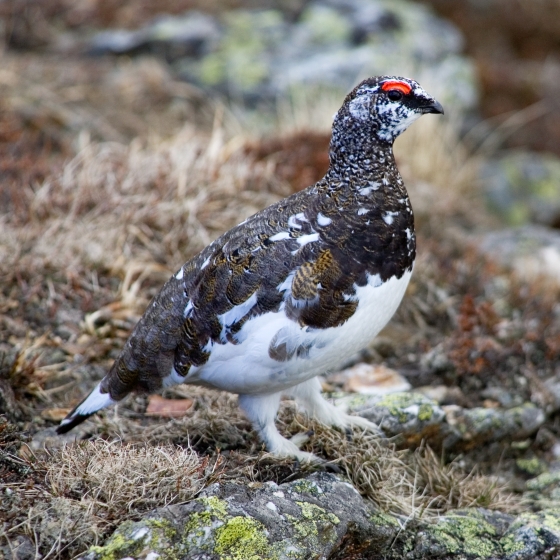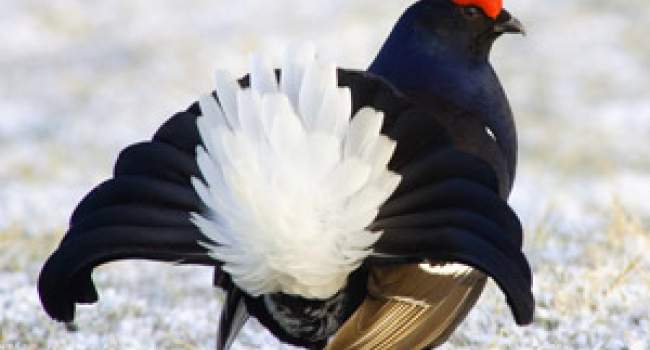Ptarmigan
Lagopus muta (Montin, 1781)
PM
 PTARM
PTARM  3300
3300

Family: Galliformes > Phasianidae

Ptarmigan are associated with tundra habitat across their range, which is why their small UK population is restricted to Scotland's mountains.
Ptarmigan are especially adapted for cold conditions. In winter they develop thick feathers on their feet, which act as snow-shoes, and individuals develop white plumage that provides camouflage against snow. In summer the upperparts are mottled brown in females and grey in males. Preferring sparsely vegetated environments, Ptarmigan consume young vegetation, berries and insects.
Ptarmigan is Red-listed in the UK as a Bird of Conservation Concern because of a severe decline in breeding numbers and the species is threatened by a warming climate. Nevertheless, Ptarmigan are still legally hunted in the UK, the open season running from 12 August to 10 December.
Identification
Ptarmigan identification is usually straightforward. The following article may help when identifying Ptarmigan.
Identifying Grouse

Grouse are classic birds of upland and wild habitats. Males are relatively easy to separate but females and distant birds can be much more difficult. Using plumage, habitat and habit clues we can tell them apart, however. Let this video help you confidently tell Red Grouse, Ptarmigan, Black Grouse and Capercaillie apart.
SONGS AND CALLS
Listen to example recordings of the main vocalisations of Ptarmigan, provided by xeno-canto contributors.
Song
Develop your bird ID skills with our training courses
Our interactive online courses are a great way to develop your bird identification skills, whether you're new to the hobby or a competent birder looking to hone your abilities.
Browse training coursesStatus and Trends
Population size and trends and patterns of distribution based on BTO surveys and atlases with data collected by BTO volunteers.
CONSERVATION STATUS
This species can be found on the following statutory and conservation listings and schedules.
POPULATION CHANGE
Popuation changes are unclear due to the difficulty in monitoring this montane species, but a range contraction of 11% has occurred since the 1968-72 breeding Atlas, with losses mostly on lower hills at the edge of the range, particularly in the north-west of their range (Balmer et al. 2013). A 50-year study on the Cairngorm mountain range showed that peaks and troughs in population from the mid-1940s had occurred and followed an approximate 10-year cycle (Watson et al. 2000).
DISTRIBUTION
Ptarmigans occupy the high tops of the Scottish Highlands, favouring montane habitats, where they are resident, though during prolonged periods of snowfall they are sometimes forced down to lower altitudes.
Occupied 10-km squares in UK
| No. occupied in breeding season | 175 |
| % occupied in breeding season | 5.8 |
| No. occupied in winter | 145 |
| % occupied in winter | 4.8 |
European Distribution Map
DISTRIBUTION CHANGE
The winter change map shows a 64% increase in the number of 10-km squares occupied by Ptarmigans, but this is likely to be due to improved coverage during Bird Atlas 2007–11
Change in occupied 10-km squares in the UK
| % change in range in breeding season (1968–72 to 2008–11) | -11.3% |
| % change in range in winter (1981–84 to 2007–11) | +63.9% |
SEASONALITY
Ptarmigans are present throughout the year but most likely under-recorded in winter owing to fewer BirdTrack lists in montane habitats.

Movement
Information about movement and migration based on online bird portals (e.g. BirdTrack), Ringing schemes and tracking studies.
RINGING RECOVERIES
View a summary of recoveries in the Online Ringing Report.
Biology
Lifecycle and body size information about Ptarmigan, including statistics on nesting, eggs and lifespan based on BTO ringing and nest recording data.
SURVIVAL & LONGEVITY
View number ringed each year in the Online Ringing Report
Typical Lifespan 
|
2 years with breeding typically at 1 year |
Adult Survival 
|
0.43±0.64 (Male: 0.71± Female: 0.57±)  
|
CODES & CLASSIFICATION
Ring size 
|
F* |
Field Codes 
|
2-letter: PM | 5-letter code: PTARM | Euring: 3300 |
For information in another language (where available) click on a linked name
Research
Interpretation and scientific publications about Ptarmigan from BTO scientists.
CAUSES AND SOLUTIONS
Causes of change
The population trend for this species is uncertain as it is difficult to monitor the whole population and hence drivers of change are also unclear. There are patricular concerns about the potential effects of climate change on Ptarmigan as the species is adapted to montane habitats. Whilst there has been no research yet to assess whether climate change has already impacted on the species in Scotland, one study has shown that the species range in some parts of the Swiss Alps has shifted uphill over 30 years (Pernollet et al. 2015). Developments (e.g. for skiing) may cause habitat changes and hence local declines, and may also cause indirect impacts by increasing access for generalist predators such as Carrion Crows. In one study in the Cairngorms, breeding success was higher at sites further from a ski development and abnormally low closer to the development where nests were lost to crows (Watson & Moss 2004).
Links to more studies from ConservationEvidence.com
- Five-year evaluation of the impact of the Arable Stewardship Pilot Scheme on birds
- Effects of reduced grazing on population density and breeding success of black grouse in northern England
- Demography of a reintroduced population of Evermann's rock ptarmigan in the Aleutian Islands
Read more studies about Ptarmigan on Conservation Evidence >
Would you like to search for another species?










Share this page